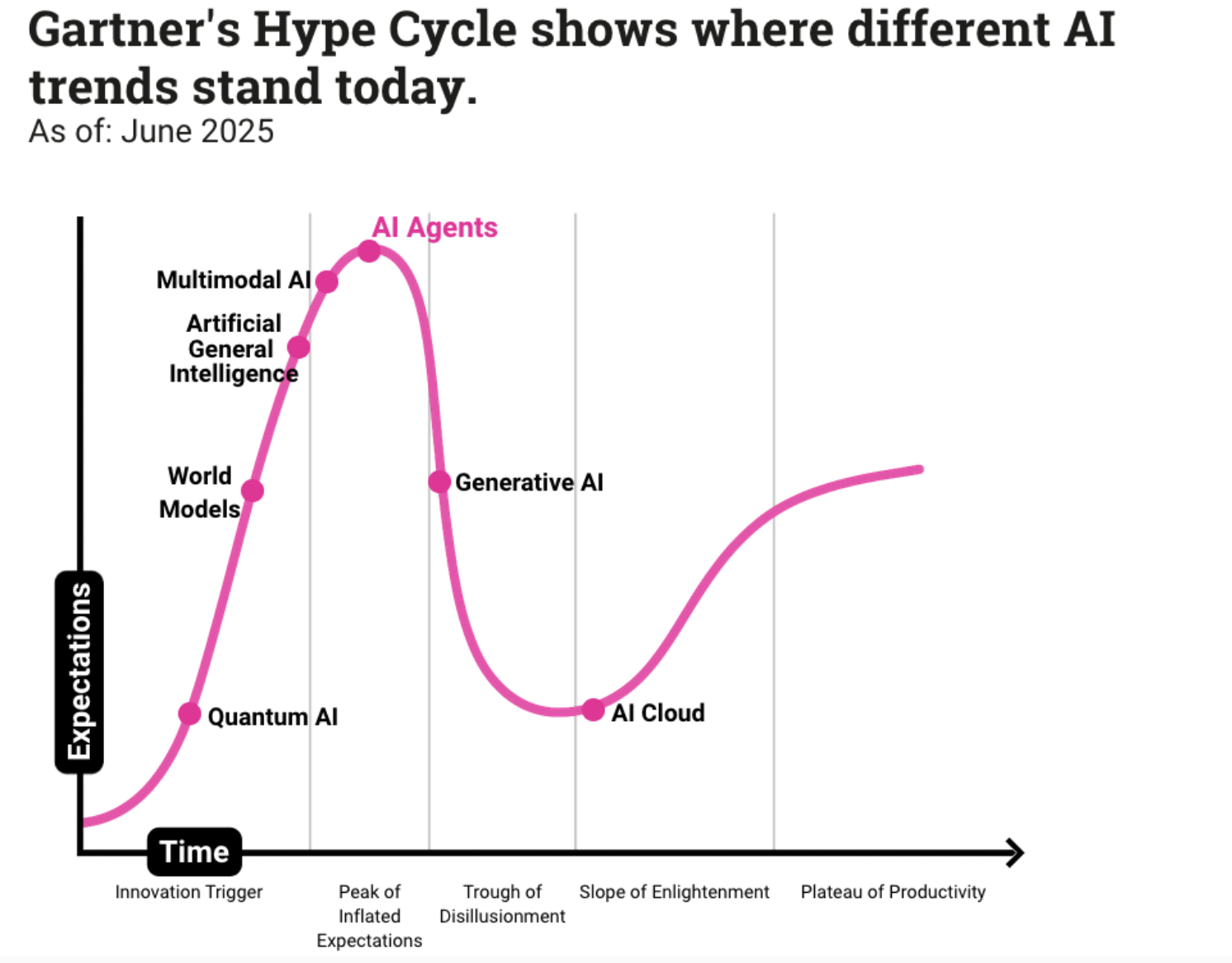Artificial intelligence has enjoyed one of the most rapid ascents to mainstream awareness in tech history. In just a few years, generative AI went from obscure lab demos to household names like ChatGPT, Copilot, and Gemini. Venture capitalists poured billions into startups, enterprises scrambled to showcase AI initiatives, and entire sectors rushed to claim an “AI-first” identity.
But hype has a half-life. Analysts are now asking: have we reached the end of the AI hype cycle? If 2023 and 2024 were about experimentation and inflated promises, what does the data from 2025 actually tell us about adoption, investment, and business value? The short answer: the hype is cooling, but the trend is stabilizing into something more sustainable. To see why, we need to unpack the numbers. In this article, you’ll learn:
- Why the AI hype is cooling, and what that means for your business
- How adoption data reveals the gap between experimentation and scaled deployment
- Which functions are seeing real productivity gains from AI, and where results remain uneven
- The key challenges slowing AI adoption, from hallucinations to integration complexity
- How businesses can move beyond hype to build sustainable AI value
- The post-hype trends shaping investment, governance, and agent-based AI systems
- Which strategies position companies to embed AI into workflows successfully
- And how Mitrix can help you design AI/ML solutions and generative AI agents tailored to your needs
Investment and funding: from frenzy to focus
The first clear signal comes from venture capital flows. According to Crunchbase, global AI funding peaked in late 2023 with record-breaking mega-rounds for foundation model companies. By mid-2024, however, deal volume began to fall. Total AI-related funding declined by nearly 30% year-over-year, a classic indicator that investors were pulling back from speculative bets.
This doesn’t mean AI money has dried up. Instead, funds are shifting from splashy bets on general-purpose models toward application-specific startups. Healthcare AI, verticalized copilots, and infrastructure tooling now attract most of the new checks. In other words, the market is narrowing its focus to fewer moonshots and more domain-driven plays.
Public markets echo the same pattern. After a blistering rally, AI-adjacent stocks have cooled. Analysts note that companies unable to demonstrate near-term ROI from AI initiatives have seen valuations compress. The message from investors is clear: “Prove the business case, or expect the hype premium to fade”.
Media coverage: from “AI will change everything” to “what works”
The second lens is media attention. In 2023, headlines proclaimed AI as the single biggest transformation since the internet. For instance, nearly half of The Wall Street Journal’s coverage cast AI in a favorable light, while a quarter of the articles explored it through three main lenses: a substitute for human work, a superior performer, and an almost human-like actor.

Gartner’s hype cycle
By 2025, the tone has shifted. Tech journalists are no longer dazzled by demos: they are scrutinizing outcomes, ethics, and compliance. This data reflects a familiar pattern: initial overexcitement gives way to skepticism, and the real test is whether the technology can demonstrate lasting business value.
Adoption reality: pilots vs. scale
One of the clearest signals that the AI hype cycle is cooling isn’t in headlines or keynote speeches, but in what companies are actually doing. Boardrooms may still buzz with “AI strategy” talk, but when you examine adoption data, the gap between ambition and execution becomes hard to ignore.
- McKinsey’s 2024 AI survey found that while 65% of enterprises had piloted at least one generative AI initiative, fewer than 12% had scaled it into production workflows.
- Stanford’s AI Index 2025 reports that AI mentions in earnings calls skyrocketed in 2023 but plateaued in 2024, with executives now emphasizing “responsible rollout” and “pilot learnings” rather than big-bang deployments.
- Among SMBs, adoption lags even further. High integration costs, lack of internal expertise, and unclear ROI keep most companies in the exploration phase.
The reality is simple: AI may dominate conversations, but it hasn’t yet taken over operations. The technology’s potential is real, but businesses are moving cautiously, weighing risks against rewards. The winners will be the ones who methodically build the foundations for durable, scalable AI adoption.
Productivity vs. pitfalls
The story of AI adoption is all about uneven results. While the technology has broken through in some functions, its impact elsewhere remains patchy. The balance sheet of wins and setbacks paints a more realistic picture than the hype suggests.
Positive impact areas
- Software development. Code copilots like GitHub Copilot and Replit’s AI have shown measurable productivity gains, cutting routine coding tasks by 20-50%.
- Customer service. AI-driven chatbots now handle high volumes of tier-1 support, reducing response times and ticket costs.
- Marketing automation. Content generation and campaign testing benefit from AI’s ability to produce variations at scale.
Challenges holding adoption back
- Hallucinations. Generative AI still produces confident but false outputs, limiting its role in high-stakes decision-making.
- Compliance and data privacy. Concerns over data leakage and vendor sovereignty slow down deployments in regulated industries. Around 25% of companies acknowledge reputational risks tied to their AI adoption, while 15% highlight ethical concerns linked to its use.
- Integration pain. Businesses underestimate the complexity of embedding AI into legacy workflows, leading to failed pilots.
- ROI ambiguity. While cost savings are clear in some use cases, direct revenue impact remains harder to quantify.
This mixed track record explains why both investors and executives are tempering expectations. AI is just another tool that needs infrastructure, training, and oversight. The organizations that treat AI as part of a disciplined transformation strategy (rather than a one-off experiment) will be the ones that turn promise into performance.
The end of hype doesn’t mean the end of AI
If hype is fading, does that mean the AI revolution is over? Well, hardly. History shows a different pattern.
- The Internet (1990s). The Dot-com bubble burst, but the infrastructure built during the hype laid the foundation for today’s digital economy.
- Cloud computing (2000s). Initially dismissed as risky, later became the backbone of enterprise IT.
- Mobile apps (2010s). The early gold rush faded, but mobile-first platforms now dominate consumer engagement.
In fact, AI is following a similar arc. This way, the end of hype is not collapse, but rather its normalization. As adoption matures, AI will shift from being a “feature” to being invisible infrastructure, powering decisions, workflows, and interactions in the background.
Data-driven outlook: where AI goes next
When the dust of hype begins to settle, patterns become easier to see. The signal finally rises above the noise. Looking at the numbers, several trends stand out for the post-hype phase:
- Targeted investment. Funding will concentrate in vertical AI (healthcare diagnostics, legal tech, logistics optimization) where ROI is clearer and data advantage matters.
- Integration, not novelty. The most successful companies won’t be those shouting “AI-first,” but those embedding AI into existing workflows where it quietly boosts efficiency.
- Governance and compliance as differentiators. Data sovereignty, regulatory compliance, and transparent AI governance will become selling points. Expect a rise in vendors that offer enterprise-ready, auditable AI.
- Agent-based systems and interoperability. The next wave of innovation is shifting toward AI agents that can collaborate, plan, and execute multi-step tasks. Early research from OpenAI, Google, and startups like Adept suggest this will define the next chapter.
- Consolidation and shakeout. While it’s a fact that thousands of AI startups launched during the hype years, yet most of them will not survive. The market is headed for consolidation, leaving a handful of dominant infrastructure players and a select group of vertical specialists.
AI’s trajectory mirrors that of other general-purpose technologies: initial frenzy, a reality check, and then steady integration into the fabric of business. For leaders, this is the moment to think less about hype and more about execution. Those who invest in solid foundations, governance, and targeted use cases will be best positioned when AI moves from headline trend to everyday infrastructure.
How Mitrix can help
One way or another, companies across industries want to do more than just chase the hype, they want to build sustainable value. At Mitrix, we deliver AI/ML and generative AI development services that help companies:
- Design intelligent bots that understand supply chain workflows
- Integrate chatbots with tracking systems, CRMs, ERPs, and TMSs
- Build multilingual, multi-channel support agents (WhatsApp, web, SMS)
- Monitor performance and apply machine learning for ongoing improvements
At Mitrix, we build AI agents designed around your needs, whether you’re looking to boost customer support, unlock insights from data, or streamline operations. Let’s create a robust AI agent tailored to transform your business!
Customer support agent
Delivers 24/7 customer assistance, resolves inquiries efficiently, addresses issues, and enhances overall customer satisfaction.
Healthcare assistant
Performs preliminary symptom assessments, organizes patient records, and provides accurate medical information.
Financial advisor
Delivers tailored investment advice, monitors market trends, and creates personalized financial plans.
Sales agent
Identifies and qualifies leads, streamlines sales processes, and drives growth by strengthening the sales pipeline.
Data analysis agent
Processes and interprets large datasets, delivers actionable real-time insights, and aids in strategic decision-making.
Virtual assistant
Organizes schedules, manages tasks, and provides timely reminders to enhance productivity.
Whether you’re coordinating international freight, managing warehouse logistics, or optimizing last-mile delivery, Mitrix can help build the chatbot system to match. Contact us today to discuss your virtual assistant!
Summing up
So, is it the end of AI hype? The data suggests yes, and the fever pitch of 2023 has cooled. Investment has contracted, media coverage is more skeptical, and enterprise adoption remains cautious. But hype cooling isn’t bad news. In fact, it’s necessary. Without the inflated expectations bursting, the industry can’t enter its next, more sustainable phase. The real story of AI is about productivity gains, risk management, and incremental improvements that compound into structural change.
AI is no longer the shiny object that dominates every conference keynote. It is becoming what all transformative technologies eventually become: a workhorse. The noise may be fading, but the signal is stronger than ever. aFor businesses, the implication is clear: stop chasing hype and start asking hard questions. Where does AI truly fit into your strategy? What workflows can it streamline? How will you manage risks? Those who move past the hype and build with discipline will be the ones still standing when the dust settles. And that is where the real value of AI will be proven.


